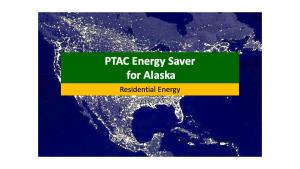
TIME TO ACT: Save 20% or more on HVAC. It’s important now more than ever for a sustainable future!
Optimizing PTAC units with a “smart” device is a fast, easy, and cost-effective way to achieve Residential HVAC Energy Savings. A Packaged Terminal Air Conditioner is a type of self-contained heating and air conditioning system commonly found in: Hotels, Motels, Senior Housing Facilities, Hospitals, Condominiums, Apartment Buildings, and Add-on Rooms & Sunrooms.
Business owners and homeowners face increasing challenges with energy costs to save energy and money in Alaska. PTAC Energy Saver offers an Adaptive Climate Controller (ACC). It is a proven HVAC energy saving devicethat quickly installs on PTAC units. There are many companies that claim to produce energy savings, but the ACC device is multi-panted and proven over many years. Plus, it has extensive validation tests by organizations such as:
- ConEdison, Manhattan Plaza New York City
- Environmental Test Laboratory, Ohio
- EME Consulting Engineers (Third Party), Sponsored by NYSERDA, New York
- State University of New York, Oneonta, NY
- Tim Garrison (Third Party Testing)
- McQuay Cooling Tests
- Purdue University Tests (Phoenix)
- ConEdison Tests by ERS
Typically, when an HVAC system turns off, shortly after, the blower fan motor turns off. The ACC reprograms the blower fan not to shut off but to throttle back the rpm airflow to an exceptionally low speed, quiescent level airflow or “idle speed”. This allows for a gentle but continuous air movement into the building that helps keep equilibrium of climate conditions in the occupied space and saved energy.
PTAC Energy Saver can help you navigate the complexity of HVAC energy saving choices: CONTACT PTAC Energy Saver
Here is an example of some Residential HVAC Energy Saving info for Alaska:
When the north wind blows into Dillingham in the middle of winter, it can plunge well past 15 degrees below zero F on the remote strip of Alaska’s southern coast. On these days, the oil heaters in many of the homes have to run pretty much nonstop to keep people warm.
As you walk through the small fishing town, perched on Bristol Bay’s world-class salmon fishery, you can smell the acrid-sweet scent of wood-burning stoves. But one house stands out from the others: Located on the edge of the town, where spruce forest fades into an endless expanse of frozen, snow-covered tundra, it has no chimney, no fuel tank, no combustion of any kind.
The air-source heat pump that Tom Marsik installed in his house eight years ago was rare for Alaska. Air-source heat pumps take heat from the outside air, run it through a refrigeration cycle to step up the temperature (just like your fridge, but in reverse), and deliver it to a building. Because they rely on “heat” from the outside air, they were not very common in subarctic climates. Yet, for five years, Marsik’s heat pump kept his family warm even on the chilliest days of the year. Thanks to what researchers have learned from systems like this one, heat pumps are taking off in Alaska and other cold places as an alternative to more traditional heating systems like oil and natural gas.
“It’s exciting because they are operating at lower temperatures than they historically have, which means they have the potential to reduce the consumption of fossil fuels in cold climates,” Marsik said. “Helping to push the boundaries of clean energy and develop a sustainable future was important to me, especially in my own house, where we were raising our daughter.”
Today, Marsik lives in Fairbanks and is chief scientist at the National Renewable Energy Laboratory’s (NREL’s) Cold Climate Housing Research Center (CCHRC). Though he does not live in an air-source-heat-pump-heated home anymore, he still spends a lot of time thinking about them, calculating runtimes and defrost cycles, remembering how he would come running downstairs when he would hear a new noise from his own unit, and researching how to make heat pumps work better for more Alaskans, who face a severe climate, lack of infrastructure, and energy bills five times higher than the average American.

